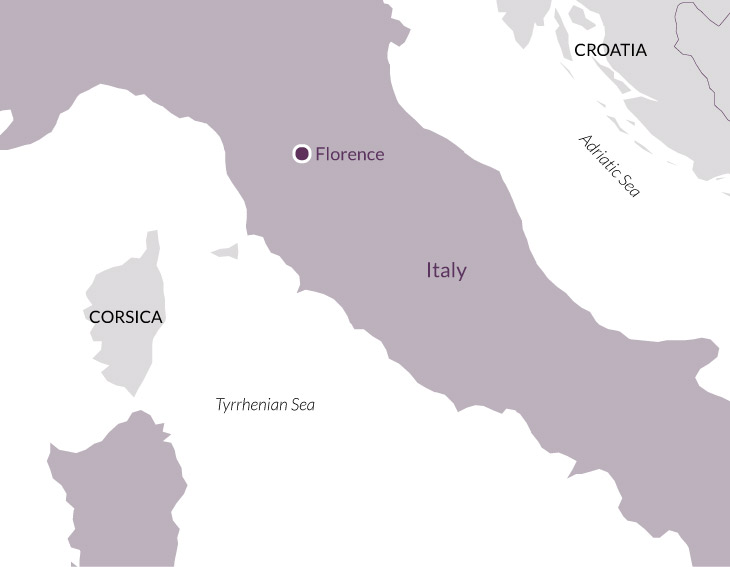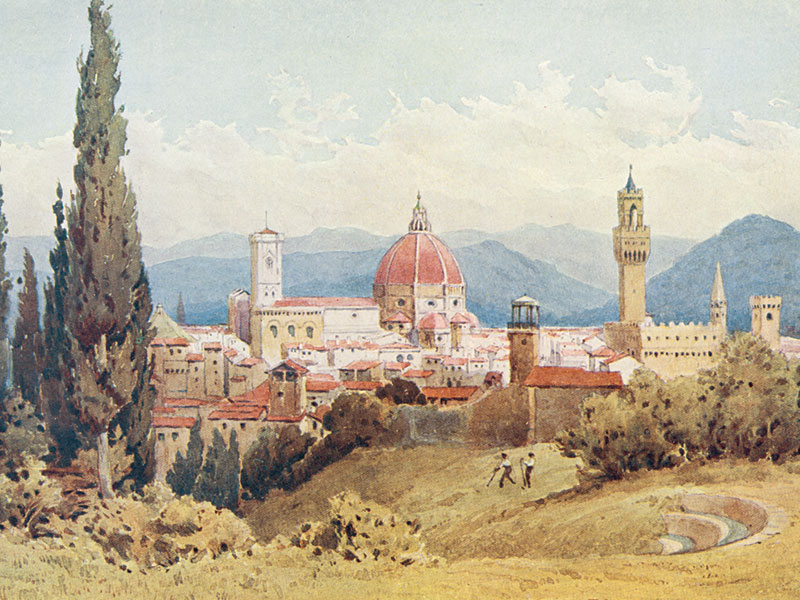Overview
A first visit to Florence can be an overwhelming experience, and it seems that no amount of revisiting can exhaust her riches, or stem the growth of affection and awe which the city inspires in regular cultural pilgrims.
For hundreds of years the city nurtured an unceasing succession of great artists. No other place can rival Florence for the quantity of first-rate, locally produced works of art, many still in the sites for which they were created or in museums a few hundred yards away. Giotto, Brunelleschi, Donatello, Masaccio, Botticelli, Michelangelo, Raphael, Leonardo – these are some of the artists and architects whose works will be studied on the tour, fully justifying Florence’s epithet as the cradle of the Renaissance.
Florence is, moreover, one of the loveliest cities in the world, ringed by the foothills of the Apennines and sliced in two by the River Arno. Narrow alleys lead between the expansive piazze and supremely graceful Renaissance arcades abound, while the massive scale of the buildings impressively demonstrates the wealth once generated by its precocious economy.
It is now a substantial, vibrant city, yet the past is omnipresent, and, from sections of the medieval city walls one can still look out over olive groves and lines of cypress trees.
Though the number of visitors to Florence has swelled hugely in recent years, it is still possible during the quieter months, and with careful planning, to explore the city and enjoy its art in relative tranquillity.
Day 1
Fly at c. 11.30am (British Airways) from London City to Florence. In the late afternoon visit the chapel in the Palazzo Medici-Riccardi, which has exquisite frescoes by Benozzo Gozzoli.
Day 2
Visit Michelangelo’s Laurentian Library, whose architectural components would herald the onset of Mannerism. A Medici morning includes S. Lorenzo, the family parish church designed by Brunelleschi and their burial chapel in the contiguous New Sacristy with Michelangelo’s enigmatic sculptural ensemble. In the afternoon see the Byzantine mosaics and Renaissance sculpture in the cathedral baptistry, and the superbly renovated cathedral museum.
Day 3
Brunelleschi’s Foundling Hospital, begun in 1419, was the first building to embody stylistic elements indisputably identifiable as Renaissance. See Michelangelo’s David, the ‘Slaves’ in the Accademia and the frescoes and panels of pious simplicity by Fra Angelico in the Friary of S. Marco. In the afternoon visit Piazza della Signoria, civic centre of Florence with masterpieces of public sculpture, then continue to the Uffizi which has masterpieces by every major Florentine painter as well as international Old Masters.
Day 4
In the morning visit S. Maria Novella, the Dominican church with many works of art (Masaccio’s Trinità, Ghirlandaio’s frescoed sanctuary). See the Rucellai Chapel in the deconsecrated church of S. Pancrazio, now part of the Museo Marino Marini. Free afternoon.
Day 5
Visit the Bargello, housing Florence’s finest sculpture collection with works by Donatello, Verrocchio, Michelangelo and others. Walk to the vast Franciscan church of S. Croce, favoured burial place for leading Florentines and abundantly furnished with sculpted tombs, altarpieces and frescoes. Lunch is at a restaurant on the Piazzale Michelangelo before a visit to S. Miniato al Monte, the Romanesque abbey church with panoramic views of the city.
Day 6
In the morning visit the redoubtable Palazzo Pitti, which houses several museums including the Galleria Palatina, outstanding particularly for High Renaissance and Baroque paintings. Visit S. Spirito, Brunelleschi’s last great church, with many 15th-century altarpieces, and the extensive Boboli Gardens, at the top of which is an 18th-century ballroom and garden overlooking olive groves. See the Masaccio/Masolino fresco cycle in the Brancacci Chapel, a highly influential work of art which guided all subsequent generations of Renaissance artists.
Day 7
See the Renaissance statuary at the church-cum-granary of Orsanmichele (exterior), and there is a second, selective visit to the Uffizi. Fly from Florence Airport, arriving at London City at c. 5.30pm.
Price, per person
In 2023. Two sharing: £2,950 or £2,700 without flights. Single occupancy: £3,340 or £3,090 without flights.
In 2024. Two sharing: £3,060 or £2,710 without flights. Single occupancy: £3,460 or £3,110 without flights.
Suggested train route: London – Paris – Turin – Florence: c. 13 hours.
Included
Flights (economy class) with British Airways (Embraer E190); travel by private coach for airport transfers; hotel accommodation; breakfasts, 1 lunch, 4 dinners with wine, water, coffee; all admissions; all tips; all taxes; the services of the lecturer and tour manager.
Accommodation
Hotel Santa Maria Novella, Florence: a delightful, renovated 4-star hotel in a very central location. Single rooms are doubles for sole use.
How strenuous?
The tour involves a lot of walking in the town centre where the ground is sometimes uneven and pavements are narrow. It should not be attempted by anyone who has difficulty with everyday walking and stair-climbing. Fitness is essential.
Are you fit enough to join the tour?
Group size
Between 8 and 18 participants.
Travel advice
Before booking, please refer to the FCDO website to ensure you are happy with the travel advice for the destination(s) you are visiting.
Combine with
2024:
Essential Andalucia, 4–14 March 2024
Art in Texas, 6–16 March 2024
The Story of Venice, 10–15 March 2024
Ravenna & Urbino, 11–15 March 2024
Venetian Palaces, 26–30 March 2024
Minoan Crete, 29 March–6 April 2024

'Each day was varied and of course Florence enabled the whole tour to be done on foot which was enjoyable.'
'The lecturer and tour manager both worked to create an atmosphere of complete confidence and reliability from the outset.'
'We cannot speak too highly of the comprehensive nature of the itinerary given the time available. It provided a good balance of political and social developmental history and the chronology of the emergence of the key players and artists who established Florence as the Cradle of the Renaissance.'
